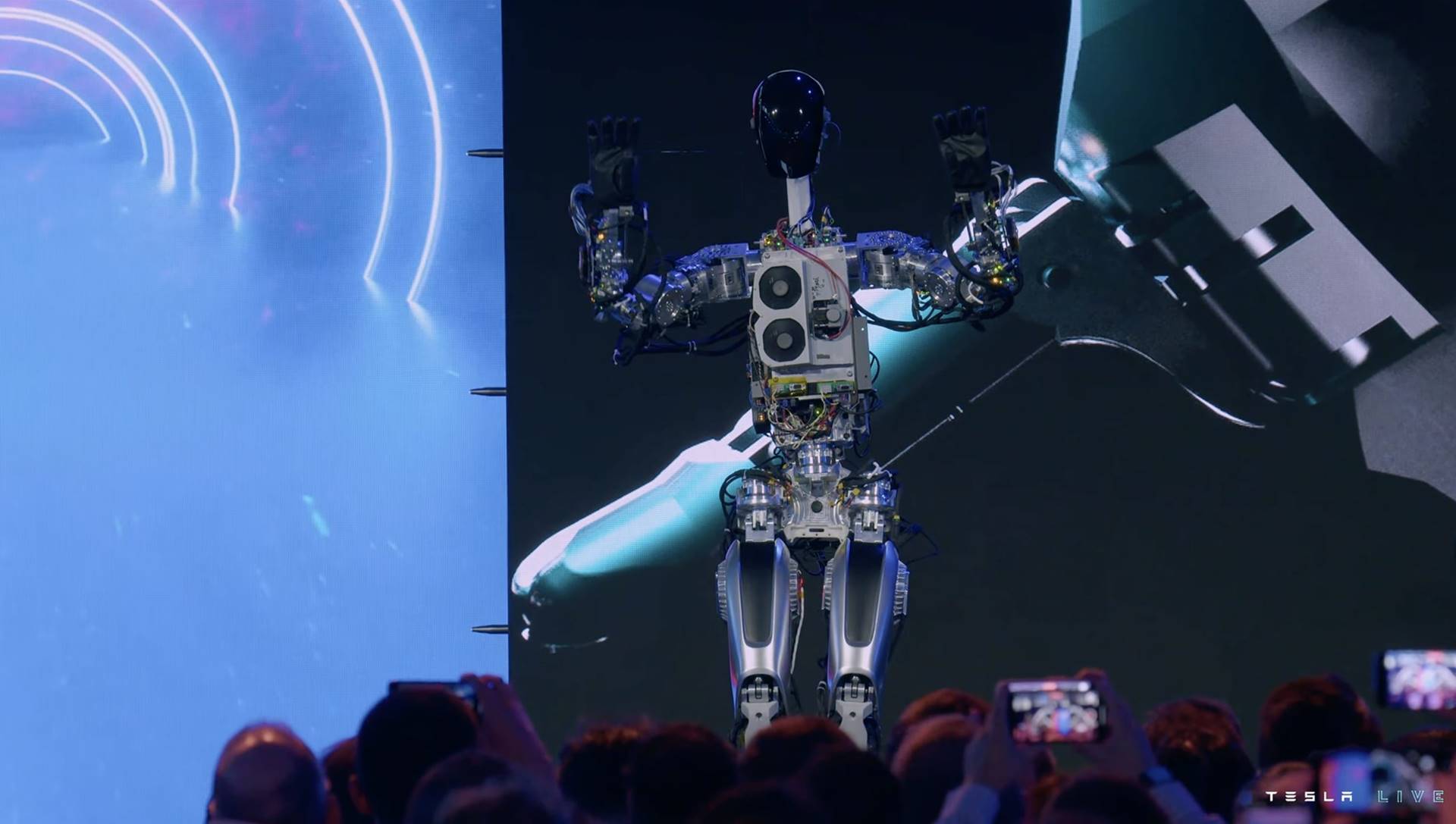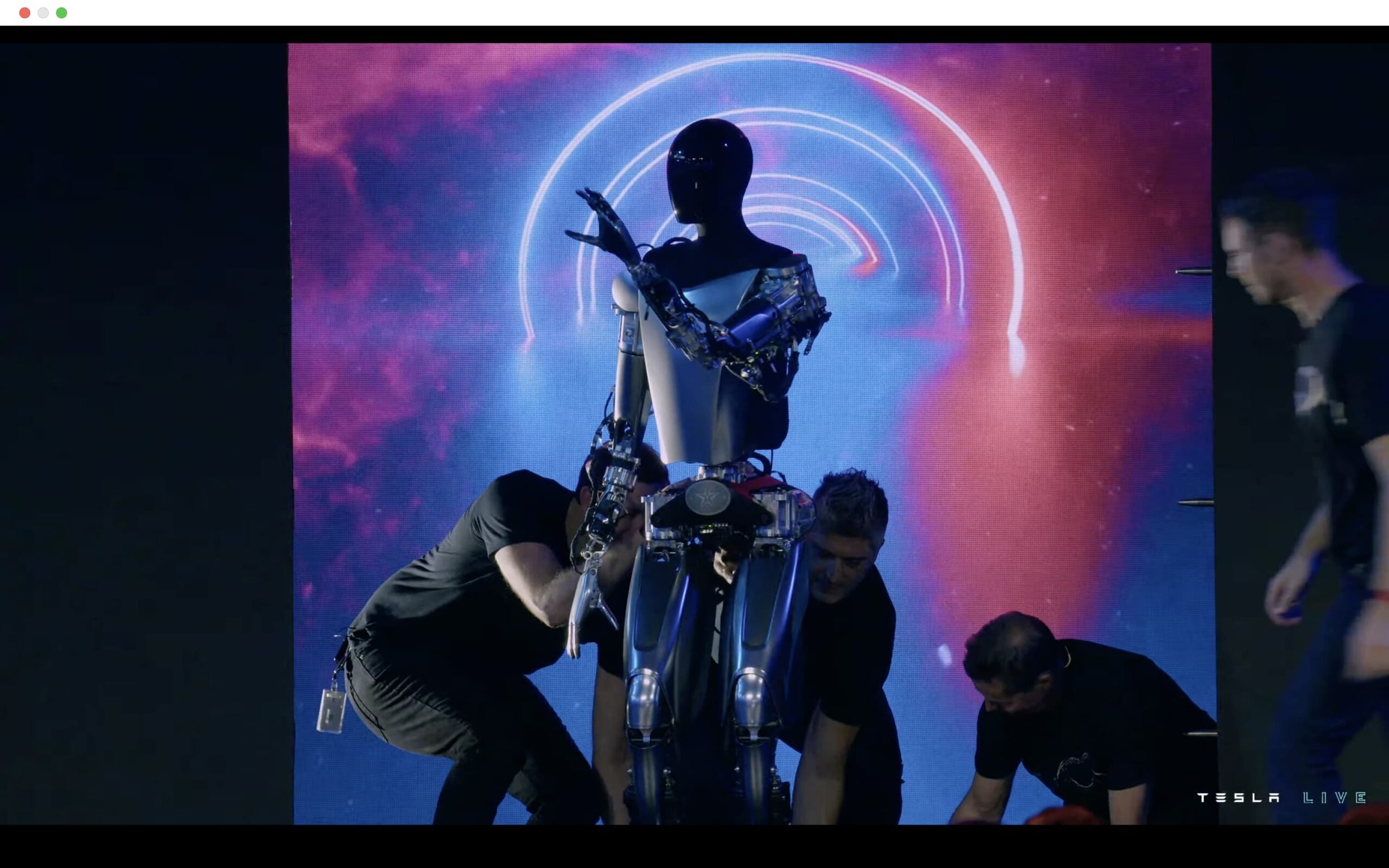Elon Musk shows off humanoid robot prototype at Tesla AI Day

Tesla CEO Elon Musk and other leaders from the automaker’s AI and hardware teams spoke at the company’s 2022 AI Day, an engineer-recruiting event in Palo Alto, Calif., on Friday night.
During the last AI Day in August 2021, Musk said Tesla was building a humanoid robot, known as the Tesla Bot or Optimus. The company didn’t have so much as a prototype to show at that time, and instead presented a dancer, dressed in a Tesla Bot spandex unitard on stage.
This year, Musk and Tesla employees who joined him on stage showed off a bipedal humanoid robot, which they said was only a “rough development robot,” walking and waving its hands in the air. They said the robot was walking around for the first time without any mechanical support on stage in Palo Alto.
Related Articles:
- Elon Musk criticized after China space complaint to UN
- Tesla CEO Elon Musk give a miss to the quarterly ritual of talking to Wall Street
- Elon Musk says he confronted Bill Gates about shorting Tesla
To warm up the audience, which included Tesla-focused social media influencers, Musk said, ″We’re going to talk about the advancements in AI for Full Self-Driving, as well as how they apply more generally to real-world AI problems like a humanoid robot and even going beyond that. I think there’s some potential that what we’re doing here at Tesla could make a meaningful contribution to AGI [artificial general intelligence].”
He continued, “And I think actually Tesla’s a good entity to do it, from a governance standpoint, because we’re a publicly-traded company with one class of stock. That means that the public controls Tesla, and I think that’s actually a good thing. So if I go crazy, you can fire me — this is important. Maybe I’m not crazy.”
Elon Musk previously co-founded (and later quit) an artificial intelligence venture called OpenAI. In 2015, OpenAI boasted that it had trained neural networks to enable a robot hand resembling a human hand to solve a Rubik’s Cube puzzle.
Back when Musk originally floated the Tesla Bot concept at AI Day 2021, he said, “It should be able to, ‘please go to the store and get me the following groceries,’ that kind of thing.” Later, Musk said robots made by Tesla could one day be worth more than its cars, and that thousands of them would be put to work in Tesla factories, where humans build cars and batteries.
During Friday’s presentation, Tesla employees showed off how the humanoid robot they are developing might function in the future, including Tesla-designed actuators, which are like the muscle of the robot, and adaptive robotic hands that will allow the robot to grasp and manipulate a wide range of objects.
Milan Kovac, who is Director of Engineering for Autopilot at Tesla according to his LinkedIn profile, said that the company’s experiences developing driver assistance systems for Tesla vehicles, in particular computer vision systems, we’re helping the company figure out how to make a humanoid robot work in the real world.
While robotics experts have said that Tesla does not require a bipedal robot in order to put better automation to work in its factories, Tesla employees spoke at length on Friday about their dedication to the human form. Employees also said they were working on special batteries and actuators for their robots to keep power consumption to a minimum so their robots could work for a full day on a single charge.
Tesla Autopilot employees also spoke extensively about their quest to make Tesla cars autonomous without adding any new hardware to them.
In the past, the company’s Autopilot team relied on manual data annotation to identify and describe objects in short video clips that were captured by cameras and sensors on Tesla vehicles. Data labelers would identify things like road boundaries, lane markings, or overlapping objects such as a pedestrian obstructing the full view of a stop sign.
The labeled clips serve to train Tesla’s neural networks and improve driver assistance systems that enable their cars to navigate around, automatically avoiding obstacles, with driver oversight.
Now, Tesla says they have developed auto-labeling technology which allows the company to chew through half a million clips each day. In the end, a human comes in to “finalize” labels but they have a boost from the auto-labeling system.
The presenters also discussed, in great detail, how many improvements they were making to Tesla-designed chips and data infrastructure. They did not say when a self-driving car that’s safe to use without a human driver behind the wheel in normal traffic would be available to paying customers.

Musk explained that Tesla was holding this AI Day event, and showing off its robot prototype, “to convince some of the most talented people in the world like you guys, to join Tesla and help make it a reality.”
The CEO thinks the humanoid robot “can help millions of people,” he said because if it works, the world will have what he called “a future of abundance, a future where there is no poverty, where people you can have whatever you want in terms of products and services.”
In his signature grandiose manner, Musk said, “It really is a fundamental transformation of civilization as we know it.”
After the CEO had left the stage but while the AI Day presentation was still underway, Musk wrote to his 107.4 million followers on Twitter, “Naturally, there will be a catgirl version of our Optimus robot.”
During a question-and-answer session, Musk admitted that developing a humanoid robot was not precisely in line with Tesla’s mission of accelerating the world’s transition to sustainable energy. He said Optimus expands the Tesla mission to “making the future awesome.”
He said he thinks in 3 to 5 years, customers will be able to buy an Optimus.
An attendee asked Musk if he envisioned Tesla selling its Dojo supercomputer, which it uses for AI machine learning, to other companies. Musk said he thinks it makes more sense to offer a Dojo service, something like AWS, which he described as a “service that you can use that’s available online where you can train your models way faster and for less money.”
Big promises
When Musk makes big promises, skeptics scoff and his loyal fans swoon.
The celebrity CEO has been promising self-driving electric vehicles since 2016 and has raised billions in capital for Tesla by promising shareholders that Tesla’s autonomous vehicle tech would enable customers to turn their cars into working Robotaxis with just a software update.
While Musk said a coast-to-coast driverless demo would happen by the end of 2017, to this day Tesla has only released driver assistance systems that need to be constantly supervised by a human driver.
Tesla’s driver assistance systems, which are marketed as Autopilot, Enhanced Autopilot, FSD (short for Full Self-Driving capability), and FSD Beta in the US, have drawn federal and state-level safety probes, and allegations of false advertising including by the California DMV and a number of its own customers.
Tesla also has a rocky record with automation in its factories. In 2018, after trying to automate various aspects of vehicle production and quality assurance, Musk admitted that “excessive automation at Tesla was a mistake,” and “humans are underrated.”
Tesla is expected to post its third-quarter vehicle production and deliveries report within days of the recruiting event. Deliveries are the closest approximation for sales disclosed by Tesla and the quarterly delivery reports are closely watched by shareholders.
Napomena o autorskim pravima: Dozvoljeno preuzimanje sadržaja isključivo uz navođenje linka prema stranici našeg portala sa koje je sadržaj preuzet. Stavovi izraženi u ovom tekstu autorovi su i ne odražavaju nužno uredničku politiku The Balkantimes Press.
Copyright Notice: It is allowed to download the content only by providing a link to the page of our portal from which the content was downloaded. The views expressed in this text are those of the authors and do not necessarily reflect the editorial policies of The Balkantimes Press.
